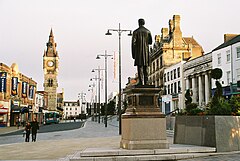Darlington
| Darlington | |
|---|---|
 Darlington town centre |
|
| Darlington shown within County Durham | |
| Population | 105,564 (2011) |
| • Density | 534.569/km2 (1,384.527/sq mi) |
| OS grid reference | NZ289147 |
| • London | 219 mi (352 km) |
| Unitary authority | |
| Ceremonial county | |
| Region | |
| Country | England |
| Sovereign state | United Kingdom |
| Post town | DARLINGTON |
| Postcode district | DL1, DL2, DL3 |
| Dialling code | 01325 |
| Police | Durham |
| Fire | County Durham and Darlington |
| Ambulance | North East |
| EU Parliament | North East England |
| UK Parliament | |
| Website | www |
Darlington is a large market town in County Durham, in North East England, and part of the Tees Valley. With a population of 106,000 in 2011, the town lies on the River Skerne, a tributary of the River Tees. The town owes much of its development to the influence of local Quaker families in the Victorian era, and is famous as the terminus of , the world's first passenger railway. The town is often colloquially referred to as 'Darlo'.
Darlington started life as an Anglo-Saxon settlement. The name Darlington derives from the Anglo-Saxon Dearthington, which seemingly meant 'the settlement of Deornoth's people', but by Norman times the name had changed to Derlinton. During the 17th and 18th centuries the town was generally known by the name of Darnton.
Darlington has a historic market area in the town centre. Built in 1183, the Grade I listed St Cuthbert's Church is one of the most important early English churches in the north of England. However the oldest church in the town happens to be that of St Andrew's Church built around 1125 and presides in the Haughton area of Darlington.
Visiting during the 18th century, Daniel Defoe noted that the town was eminent for "good bleaching of linen, so that I have known cloth brought from Scotland to be bleached here". However he also disparaged the town, writing that it had "nothing remarkable but dirt" (the roads would typically be unpaved at the time).
The Durham Ox came from Darlington.
During the early 19th century, Darlington remained a small market town. As the century progressed, powerful Quaker families such as the Pease and Backhouse families were prominent employers and philanthropists in the area. Darlington's most famous landmark, the clock tower, was a gift to the town by the industrialist Joseph Pease in 1864. The clock's face was produced by T. Cooke & Sons of York, and the tower bells were cast by John Warner & Sons of nearby Norton-on-Tees. These bells were in fact the sister bells to those which are inside the Elizabeth Tower at the Houses of Parliament in London, the most famous of which is called Big Ben. The Darlington Mechanics Institute was opened in 1854 by Elizabeth Pease Nichol, who had made the largest donation towards its building costs. The 91-acre South Park was redeveloped into its current form in 1853, with financial backing from the Backhouse family.Alfred Waterhouse, responsible for London's Natural History Museum and Manchester Town Hall, designed the Grade II listed Victorian Market Hall in 1860, and also the Backhouse's Bank building, now a branch of Barclays, in 1864, the latter taking three years to complete.George Gordon Hoskins was responsible for much of the town's architecture in this period, such as The King's Hotel. The Darlington Free Library was built with funding from Edward Pease, and opened in 1885 when the Council accepted the gift of the purpose built, fully stocked library and agreed to run it in perpetuity.
...
Wikipedia

